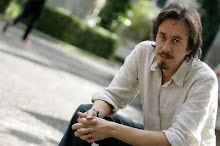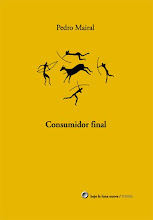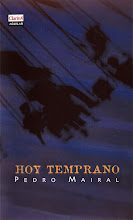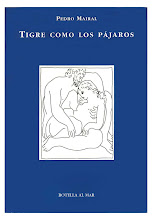SUNDAY, JUNE 22, 2008
LOS ANGELES TIMES
BOOKS & IDEAS
BOOKS & IDEAS
.
The new Argentine wave
Emerging from the cultural debris of a battered nation, these writers connect with earthy themes reflecting their turbulent times.
By Reed Johnson
Times Staff Writer
Buenos Aires
Times Staff Writer
Buenos Aires
.
PEDRO MAIRAL isn’t your old college literature professor’s idea of an Argentine novelist.
Laid-back and casually attired, the 37-year-old writer first made his mark with “Una noche con Sabrina Love” (A Night With Sabrina Love), the cyber-picaresque tale of a spirited 18-year-old boy whose fantasies get upended by fact after winning a night with the porn star of his dreams.
An online adventurer himself, Mairal operates his own blog and adopts various online personas, including women. He enjoys testing out virtual identities as a way of conceiving new fictional characters, some of whom end up in his novels.
“It’s very liberating, for the fact that one has a name, a social condition, a sex, an epoch. One is born very limited,” says Mairal, nursing a beer at the Opera Bar on Corrientes Avenue in the downtown heart of this city’s bookstore- and cafelined literary haunts.
Serious fiction in this country used to revolve around brain-teasing plots filled with jazz-like philosophical riffs. Today it’s more likely to revolve around porn stars, Renaissance-era sexual intrigue and the emotional infidelities of married men. But don’t get the wrong idea: Argentine fiction is still serious stuff, but it reflects changing times and values in a country that has long regarded itself as South America’s most urbane, bookish and “European.”
Ask a typical North American reader to name an Argentine writer and they may cough up Borges and, after a beat or two, Cortázar.Which is fine, except that Jorge Luis Borges, the baroque fabulist, died in 1986, and Julio Cortázar, the stream-of-consciousness Surrealist, transitioned into Paris’ Montparnasse cemetery in 1984.
In the years since, Argentina has morphed from a military dictatorship into a functional, if flawed, democracy, and survived a disastrous 2001 peso crash that almost bankrupted the country. It also has experienced a cultural upheaval that has yielded a number of accomplished young fiction writers now in their late 30s and early 40s, complementing such older established writers as Tomás Eloy Martínez and César Aira.
Yet few of their works can be found in translation in the U.S. Unlike the literary coterie behind the so-called “Latin American boom” of the 1950s and ’60s (Carlos Fuentes, Gabriel García Márquez, Mario Vargas Llosa, Cortázar et al.), the new generation of Argentine writers still hasn’t penetrated popular awareness outside the Cono Sur.
Although one or two contemporary South American writers, such as the late Chilean Roberto Bolaño lately have gained a wider following among Anglophone readers, the new generation of Southern Cone authors so far hasn’t matched its elders’ global influence.
That may be about to change a bit. At last, a handful of works by young and middle-age Argentine authors are finding their way into English-language editions.
An online adventurer himself, Mairal operates his own blog and adopts various online personas, including women. He enjoys testing out virtual identities as a way of conceiving new fictional characters, some of whom end up in his novels.
“It’s very liberating, for the fact that one has a name, a social condition, a sex, an epoch. One is born very limited,” says Mairal, nursing a beer at the Opera Bar on Corrientes Avenue in the downtown heart of this city’s bookstore- and cafelined literary haunts.
Serious fiction in this country used to revolve around brain-teasing plots filled with jazz-like philosophical riffs. Today it’s more likely to revolve around porn stars, Renaissance-era sexual intrigue and the emotional infidelities of married men. But don’t get the wrong idea: Argentine fiction is still serious stuff, but it reflects changing times and values in a country that has long regarded itself as South America’s most urbane, bookish and “European.”
Ask a typical North American reader to name an Argentine writer and they may cough up Borges and, after a beat or two, Cortázar.Which is fine, except that Jorge Luis Borges, the baroque fabulist, died in 1986, and Julio Cortázar, the stream-of-consciousness Surrealist, transitioned into Paris’ Montparnasse cemetery in 1984.
In the years since, Argentina has morphed from a military dictatorship into a functional, if flawed, democracy, and survived a disastrous 2001 peso crash that almost bankrupted the country. It also has experienced a cultural upheaval that has yielded a number of accomplished young fiction writers now in their late 30s and early 40s, complementing such older established writers as Tomás Eloy Martínez and César Aira.
Yet few of their works can be found in translation in the U.S. Unlike the literary coterie behind the so-called “Latin American boom” of the 1950s and ’60s (Carlos Fuentes, Gabriel García Márquez, Mario Vargas Llosa, Cortázar et al.), the new generation of Argentine writers still hasn’t penetrated popular awareness outside the Cono Sur.
Although one or two contemporary South American writers, such as the late Chilean Roberto Bolaño lately have gained a wider following among Anglophone readers, the new generation of Southern Cone authors so far hasn’t matched its elders’ global influence.
That may be about to change a bit. At last, a handful of works by young and middle-age Argentine authors are finding their way into English-language editions.
.
Disappearance of magic realism
.
ALTHOUGH cognizant of their South American roots, these writers have largely moved beyond “magic realism,” a style that dazzled readers 40 years ago in such masterpieces as García Márquez’s “One Hundred Years of Solitude” but in the hands of later, lesser talents sometimes congealed into a lumpy stew of folkloric clichés.
Mairal says that a French publisher initially rejected “Sabrina Love” because “it lacked magic realism and politics.”
But the novel struck a chord with younger Argentine readers who came of age in a more open, permissive society than their parents and who view the dictatorship that ruled from 1976 to 1983 and the disastrous Falklands War as ancient history.
Mairal’s follow-up work also has grappled with Argentina’s most au courant anxieties. The apocalyptic “El Año del Desierto” (The Year of the Desert), published in 2005, was inspired by the panic triggered by the 2001 peso crash.
It envisions a wasteland in which electricity has stopped working, potable water is in short supply and Buenos Aires is overrun with desperate rural refugees.
One thing that unites many of Buenos Aires’ young writers is their preoccupation with the city itself. Unlike the previous generation of Latin American writers that was forced into European exile by political turmoil and repression, many of today’s writers are staying put in their homelands. Like their predecessor Borges, an inveterate traipser of the city’s streets, young Argentine authors draw creative sustenance from their debonair, melancholy capital.
“I never felt I was a Latin American [writer]. I share the language of Latin America, but I’m a porteño [Buenos Aires dweller],” says Marcelo Birmajer, 41, who keeps a writing studio in the vibrant, ethnically diverse El Once neighborhood where he was born and raised.
Practically a city-within-a-city, El Once is Buenos Aires’ historic Jewish quarter, now increasingly populated by Koreans and other recently arrived immigrants. Like Buenos Aires as a whole, the barrio sports an international flavor offset by a defiantly provincial attitude. “It’s a magic barrio. It maintains its spirit, but while receiving all type of immigration, of modification,” says Birmajer.
Birmajer, the descendant of Polish, Romanian, Syrian and Lithuanian immigrants, and author of the screenplay for the 2004 film “El abrazo partido,” has set many of his 20-odd books in the neighborhood, which he pays tribute to in his beautifully written memoir, “El Once — Un recorrido personal” (2006). His stories are richly embroidered with the daily fabric of Argentine-Jewish life in a way that recalls Isaac Bashevis Singer — “my greatest master,” Birmajer says. Many deal with the spiritual and sexual tribulations of Jewish married men, and their perpetual tug of war between duty and desire. “They believe in God but they protest against God,” says Birmajer. Other mature yet still-blossoming Argentine writers are speaking to the country’s present day aspirations and neuroses, even if they are setting their fiction in faraway lands in distant times. They’re also bringing their storytelling gifts to wider audiences via other media. Federico Andahazi’s breakout novel “The Anatomist,” about a 16th century Italian surgeon whose lust for a high-priced courtesan leads him to “discover” the clitoris, is being adapted by Los Angeles-based Stone Village Pictures.
“The Anatomist,” which is published in English by Doubleday and has earned comparisons with “The Name of the Rose” and “Perfume,” became a succés de scandale after its 1997 publication in Argentina. It was awarded a top literary prize whose high-society benefactor, Amalia Lacroze de Fortabat, denounced the book for not “exalting the highest values of the human spirit.”
“The people reacted with great indignation,” says Andahazi, 45, a dapper former practicing psychoanalyst whose office walls are lined with volumes of Freud and Kafka. “It appeared to them to be much like an act of censorship.”
It didn’t escape attention in Argentina that the novel’s period setting — with its decadent ambience, Inquisitorial potentates and ego-driven arts patrons — bore more than a passing resemblance to Buenos Aires. Some even drew comparisons between the Medici dynasty and Lacroze de Fortabat, one of Argentina’s wealthiest, most politically well-connected women.
Mairal says that a French publisher initially rejected “Sabrina Love” because “it lacked magic realism and politics.”
But the novel struck a chord with younger Argentine readers who came of age in a more open, permissive society than their parents and who view the dictatorship that ruled from 1976 to 1983 and the disastrous Falklands War as ancient history.
Mairal’s follow-up work also has grappled with Argentina’s most au courant anxieties. The apocalyptic “El Año del Desierto” (The Year of the Desert), published in 2005, was inspired by the panic triggered by the 2001 peso crash.
It envisions a wasteland in which electricity has stopped working, potable water is in short supply and Buenos Aires is overrun with desperate rural refugees.
One thing that unites many of Buenos Aires’ young writers is their preoccupation with the city itself. Unlike the previous generation of Latin American writers that was forced into European exile by political turmoil and repression, many of today’s writers are staying put in their homelands. Like their predecessor Borges, an inveterate traipser of the city’s streets, young Argentine authors draw creative sustenance from their debonair, melancholy capital.
“I never felt I was a Latin American [writer]. I share the language of Latin America, but I’m a porteño [Buenos Aires dweller],” says Marcelo Birmajer, 41, who keeps a writing studio in the vibrant, ethnically diverse El Once neighborhood where he was born and raised.
Practically a city-within-a-city, El Once is Buenos Aires’ historic Jewish quarter, now increasingly populated by Koreans and other recently arrived immigrants. Like Buenos Aires as a whole, the barrio sports an international flavor offset by a defiantly provincial attitude. “It’s a magic barrio. It maintains its spirit, but while receiving all type of immigration, of modification,” says Birmajer.
Birmajer, the descendant of Polish, Romanian, Syrian and Lithuanian immigrants, and author of the screenplay for the 2004 film “El abrazo partido,” has set many of his 20-odd books in the neighborhood, which he pays tribute to in his beautifully written memoir, “El Once — Un recorrido personal” (2006). His stories are richly embroidered with the daily fabric of Argentine-Jewish life in a way that recalls Isaac Bashevis Singer — “my greatest master,” Birmajer says. Many deal with the spiritual and sexual tribulations of Jewish married men, and their perpetual tug of war between duty and desire. “They believe in God but they protest against God,” says Birmajer. Other mature yet still-blossoming Argentine writers are speaking to the country’s present day aspirations and neuroses, even if they are setting their fiction in faraway lands in distant times. They’re also bringing their storytelling gifts to wider audiences via other media. Federico Andahazi’s breakout novel “The Anatomist,” about a 16th century Italian surgeon whose lust for a high-priced courtesan leads him to “discover” the clitoris, is being adapted by Los Angeles-based Stone Village Pictures.
“The Anatomist,” which is published in English by Doubleday and has earned comparisons with “The Name of the Rose” and “Perfume,” became a succés de scandale after its 1997 publication in Argentina. It was awarded a top literary prize whose high-society benefactor, Amalia Lacroze de Fortabat, denounced the book for not “exalting the highest values of the human spirit.”
“The people reacted with great indignation,” says Andahazi, 45, a dapper former practicing psychoanalyst whose office walls are lined with volumes of Freud and Kafka. “It appeared to them to be much like an act of censorship.”
It didn’t escape attention in Argentina that the novel’s period setting — with its decadent ambience, Inquisitorial potentates and ego-driven arts patrons — bore more than a passing resemblance to Buenos Aires. Some even drew comparisons between the Medici dynasty and Lacroze de Fortabat, one of Argentina’s wealthiest, most politically well-connected women.
.
‘Restoring a volume’
.
ALTHOUGH Andahazi was only a youth at the time, the military years helped shape his life and art. He especially remembers the fateful date of March 24, 1976, when the junta deposed then-president Isabel Perón in a coup. That very night, Andahazi’s Hungarian grandfather burned his large personal library in a street bonfire, fearing that his books might make him a target for arrest.
“It was like seeing my grandfather sacrifice himself,” Andahazi says. “And unto this very day, whenever I finish a book, I have the illusion that I am restoring a volume from this lost library.”
Andahazi regrets that some of today’s young Latin American writers have shied away from dealing with the region’s dark political past. During the dictatorship, a generation of Argentine writers, such as Rodolfo Walsh and Haroldo Conti, was murdered or “disappeared,” he says. Their legacy, he believes, must be reclaimed. “Everything in this continent was massacred by military dictators. And in these massacres, always one of the greatest victims was literature.”
Andahazi, who also grew up in El Once, says that only one of his novels, the 2004 “Errante en la sombra” (Wandering in the Shade), a kind of film-noir musical whose protagonist is the chauffeur of legendary tango singer Carlos Gardel, could be considered a porteño novel. However, he acknowledges that several other of his works use different countries and eras as body doubles for modern Buenos Aires.
His novel “The Secret of the Flamencos” takes place during the Renaissance. “The Pious,” published in 1998, is set in 18th century Geneva. Andahazi describes the setting for another of his novels, “The Prince” (2000), as “a place that seems pretty much like Argentina, but not exactly.” Borges, Ricardo Piglia and others similarly have rendered the capital in disguise, or abstracted it into a multifarious city of the mind.
Yet the old, bookish Buenos Aires that inspired those imaginative flights is changing. Although the country has largely rebounded from the peso crash, a widening income gap, globalization and suburban sprawl are altering the city’s cultural identity.
“It’s not as strong as when I was 18,” Birmajer says of the city’s literary culture. “When democracy returned, you could find this until 12:30 at night. In the ’60s and ’70s they were open all night long, the bookstores. And they were full.”
Andahazi believes it will take longer for the country’s writerly class to repair the ruptures that occurred during the dictatorship. At present, he says, porteño literary culture presents “a more insular panorama” than in the past. “Each writer is like an island,” he says.
“It was like seeing my grandfather sacrifice himself,” Andahazi says. “And unto this very day, whenever I finish a book, I have the illusion that I am restoring a volume from this lost library.”
Andahazi regrets that some of today’s young Latin American writers have shied away from dealing with the region’s dark political past. During the dictatorship, a generation of Argentine writers, such as Rodolfo Walsh and Haroldo Conti, was murdered or “disappeared,” he says. Their legacy, he believes, must be reclaimed. “Everything in this continent was massacred by military dictators. And in these massacres, always one of the greatest victims was literature.”
Andahazi, who also grew up in El Once, says that only one of his novels, the 2004 “Errante en la sombra” (Wandering in the Shade), a kind of film-noir musical whose protagonist is the chauffeur of legendary tango singer Carlos Gardel, could be considered a porteño novel. However, he acknowledges that several other of his works use different countries and eras as body doubles for modern Buenos Aires.
His novel “The Secret of the Flamencos” takes place during the Renaissance. “The Pious,” published in 1998, is set in 18th century Geneva. Andahazi describes the setting for another of his novels, “The Prince” (2000), as “a place that seems pretty much like Argentina, but not exactly.” Borges, Ricardo Piglia and others similarly have rendered the capital in disguise, or abstracted it into a multifarious city of the mind.
Yet the old, bookish Buenos Aires that inspired those imaginative flights is changing. Although the country has largely rebounded from the peso crash, a widening income gap, globalization and suburban sprawl are altering the city’s cultural identity.
“It’s not as strong as when I was 18,” Birmajer says of the city’s literary culture. “When democracy returned, you could find this until 12:30 at night. In the ’60s and ’70s they were open all night long, the bookstores. And they were full.”
Andahazi believes it will take longer for the country’s writerly class to repair the ruptures that occurred during the dictatorship. At present, he says, porteño literary culture presents “a more insular panorama” than in the past. “Each writer is like an island,” he says.





